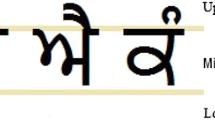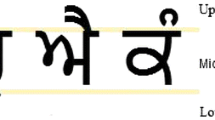Abstract
In this paper, a real-time recognition approach for online handwritten Gurmukhi character combinations with matras (Gurmukhi Vowels) has been addressed. Moreover, various challenges in the recognition of online handwritten Gurmukhi script have also been discussed. The strokes for writing Gurmukhi words can be drawn in one of the three horizontal zones, namely upper, middle and lower. With the huge variation in handwriting styles of writers, zone identification of online capturing strokes has become one of the major issues in Gurmukhi script recognition. In this connection, a robust zone identification algorithm has been proposed in this paper. We have considered 93 stroke classes (12 for upper zone and 81 for lower zone) to implement the proposed zone identification algorithm. The statistical tool, support vector machine, has been employed as the classifier for stroke classification. A total of 52,500 word samples were collected from 175 writers in order to train the classifier. The proposed zone identification algorithm yielded an accuracy of 99.75% when tested on a data set of 21,500 character combinations with matras, written by 10 new writers.








Similar content being viewed by others
References
Arora A, Namboodiri AM (2010) A hybrid model for recognition of online handwriting in Indian scripts. In: 2010 International conference on frontiers in handwriting recognition (ICFHR). IEEE, pp 433–438
Belhe S, Paulzagade C, Deshmukh A, Jetley S, Mehrotra K (2012) Hindi handwritten word recognition using HMM and symbol tree. In: Proceeding of the workshop on document analysis and recognition. ACM, pp 9–14
Chenglin L, Jaeger S, Nakagawa M (2004) Online handwritten Chinese character recognition: the state of the art. IEEE Trans Pattern Anal Mach Intell 26(2):198–213
Gao J, Zhu B, Nakagawa M (2014) Building compact recognizer with recognition rate maintained for on-line handwritten Japanese text recognition. Pattern Recognit Lett 35:169–177
Gonzalez RC, Woods RE (1992) Digital image processing. Addison-Wesley Longman Publishing Co., Boston
Hardev B (1982) Teach yourself Panjabi. Publication Bureau, Punjabi University, Patiala
Jayaraman A, Sekhar CC, Chakravarthy VS (2007) Modular approach to recognition of strokes in Telugu script. In: Ninth international conference on document analysis and recognition (ICDAR 2007). IEEE, vol 1, pp 501–505
Kumar R, Sharma RK (2013) An efficient post processing algorithm for online handwriting Gurmukhi character recognition using set theory. Int J Pattern Recognit Artif Intell 27(04):1–17
Kumar R, Sharma RK, Sharma A (2015) Recognition of multi-stroke based online handwritten Gurmukhi aksharas. Proc Natl Acad Sci India Sect A Phys Sci 85(1):159–168
Pechwitz M, Margner V (2002) Baseline estimation for Arabic handwritten words. In: Proceedings of eighth international workshop on frontiers in handwriting recognition. IEEE, pp 479–484
Plamondon R, Srihari SN (2000) Online and off-line handwriting recognition: a comprehensive survey. IEEE Trans Pattern Anal Mach Intell 22(1):63–84
Prasad MM, Sukumar M, Ramakrishnan A (2009) Divide and conquer technique in online handwritten Kannada character recognition. In: Proceedings of the international workshop on multilingual OCR, pp 1–7
Ramakrishnan AG, Urala KB (2013) Global and local features for recognition of online handwritten numerals and Tamil characters. In: Proceedings of the 4th international workshop on multilingual OCR, pp 1–16
Roy K, Bandhopadhyay A, Mondal R (2012) Stroke-database design for online handwriting recognition in Bangla. Int J Mod Eng Res 2(4):2534–2540
Sharma A, Kumar R, Sharma R (2008) Online handwritten Gurmukhi character recognition using elastic matching. In: Image and Signal Processing, 2008. CISP’08. Congress on, IEEE, vol 2, pp 391–396
Sharma A, Kumar R, Sharma R (2009) Rearrangement of recognized strokes in online handwritten Gurmukhi words recognition. In: 2009 10th international conference on document analysis and recognition, IEEE, pp 1241–1245
Sharma A, Kumar R, Sharma R (2010) HMM-based online handwritten Gurmukhi character recognition. Mach Graph Vis Int J 19(4):439–449
Singh G, Sachan M (2012) A framework of online handwritten Gurmukhi script recognition. Int J Comput Sci Technol 6(3):52–56
Tappert CC, Suen CY, Wakahara T (1990) The state of the art in online handwriting recognition. IEEE Trans Pattern Anal Mach Intell 12(8):787–808
Verma K, Sharma R (2015) Performance analysis of zone based features for online handwritten Gurmukhi script recognition using support vector machine. In: Selvaraj H, Zydek D, Chmaj G (eds) Progress in systems engineering. Advances in intelligent systems and computing, vol 366. Springer, Cham, pp 747–753
Verma K, Sharma RK (2017) Recognition of online handwritten Gurmukhi characters based on zone and stroke identification. Sādhanā 42(5):701–712
Verma K, Sharma RK (2016) Comparison of HMM-and SVM-based stroke classifiers for Gurmukhi script. Neural Comput Appl 28(1):51–63
Acknowledgements
The authors would like to thank Technology Development for Indian Languages (TDIL) Programme of Department of Electronic and Information Technology (DietY), Government of India, for sponsoring this research work.
Author information
Authors and Affiliations
Corresponding author
Ethics declarations
Conflict of interest
The authors declare that there is no conflict of interest regarding the contents of the present article.
Rights and permissions
About this article
Cite this article
Singh, H., Sharma, R.K. & Singh, V.P. Efficient zone identification approach for the recognition of online handwritten Gurmukhi script. Neural Comput & Applic 31, 3957–3968 (2019). https://doi.org/10.1007/s00521-017-3340-x
Received:
Accepted:
Published:
Issue Date:
DOI: https://doi.org/10.1007/s00521-017-3340-x




